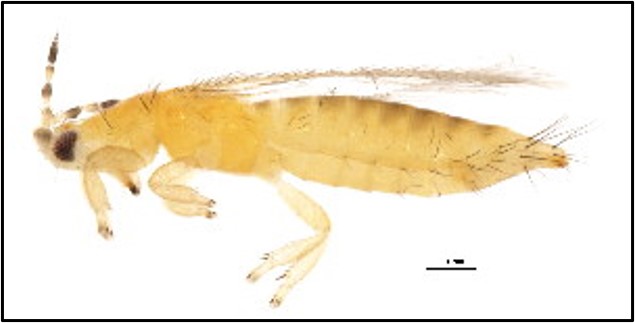It Is the Time of Year To Start Scouting for Tarnished Plant Bug, Thrips, and Mites

Now is the time to set up monitoring traps and sampling/sweeping protocols for the insects that may start showing up in berries soon. Matt Hetherington is sweeping in strawberry for his research project and while he has not seen much for insects yet, with the weather warming up again this week, insects will start showing up. Our spring insects in berries to watch out for at this time are tarnished plant bug, Eastern flower thrips, and mites.
Tarnished plant bugs (TPB; Fig 1) have not yet been observed within Dane county strawberry fields but in his scouting about 10 days ago, Matt found a TPB on a field margin. TPBs should be moving into strawberry fields soon as plants are blooming and scouting should happen at least once a week. Look for adults and nymphs as both feed on strawberry plants and can cause damage. The action threshold for implementing chemical control is 4 adults per 20 sweeps or 1 nymph in 4 flower clusters. Insecticides include Brigade and Danitol for pyrethroids and Actara and Assail for neonicotinoids. For organic production, products containing Azadirachtin have shown control in some studies. More info on TPB can also be found in this previous article.

Eastern flower thrips (EFT; Fig 2) have not yet been reported in strawberry but it is important to start monitoring for EFTs as they can be unpredictable. EFTs are known to move, sometimes in numbers, on air currents from Southern states especially early in the spring while some may overwinter on wheat in Wisconsin. To monitor for EFTs, shake or tap 10 blossoms per site at 10 or more sites per variety in a white bowl or tray. Action thresholds of 2-10 thrips per flower or small berry may warrant a chemical control, depending on your level of tolerance (for more info see previous article on EFT here). Insecticides for controlling EFTs include Brigade, Danitol, and Lorsban. These broad spectrum insecticides will also help control other insects such as strawberry clipper and tarnished plant bug. Reduced risk insecticides include Assail and Radiant and for organic production, Entrust can provide control of EFTs.

Mites. Mites can occasionally become a problem in strawberry fields and can be managed, in most cases, without the intervention of chemical control. Cultural management can be achieved with annual renovation of strawberry beds and with naturally-occurring biological control agents in the form of predatory mites that can keep two-spotted spider mite populations in check. Predatory mites move around much faster than two-spotted spider mites, and a ratio of one predatory mite to 10 two- spotted spider mites is adequate for successful biological control. In addition, avoid applying excessive nitrogen fertilization as it may cause spider mite population to build up. Pyrethroid insecticides are also known to cause mite flare ups and early season insecticide applications can reduce natural enemy populations such as predatory mites, minute pirate bugs (Orius spp.) and lady beetles, and should be avoided when possible. This emphasizes the need to use the action thresholds outlined above for EFTs and TPB to reduce chemical controls early in the season. For two-spotted spider mite, mite infestations of 25% or more of leaflets sampled (1 or more mites on 15 out of 60 leaflets sampled) will trigger the use of a miticide. Products that have shown excellent control on spider mites include Abamectin (e.g. Agri-Mek), etoxazole (e.g. Zeal), hexythiazox (e.g. Savey), bifenazate (e.g. Acramite), and fenpyroximate (e.g. Portal). In organic production, oils such as mineral oils and sesame oil have shown good control in some studies. For more info on insecticides for mites, please see this previous article.
Please refer to the Midwest Fruit Pest Management Guide for more pesticide recommendations and always read and follow the labels. Avoid spraying insecticides during bloom when pollinators are present.
Happy growing season!
This article was posted in Insects and tagged Christelle Guédot, eastern flower thrips, Mites, Tarnished Plant Bug, Thrips.
